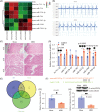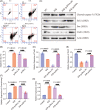MicroRNA-582-5p targeting Creb1 modulates apoptosis in cardiomyocytes hypoxia/reperfusion-induced injury
- PMID: 36301033
- PMCID: PMC9601879
- DOI: 10.1002/iid3.708
MicroRNA-582-5p targeting Creb1 modulates apoptosis in cardiomyocytes hypoxia/reperfusion-induced injury
Abstract
Background: Myocardial ischemia-reperfusion injury (MIRI) caused by the reperfusion therapy of myocardial ischemic diseases is a kind of major disease that threatens human health and lives severely. There are lacking of effective therapeutic measures for MIRI. MicroRNAs (miRNAs) are abundant in mammalian species and play a critical role in the initiation, promotion, and progression of MIRI. However, the biological role and molecular mechanism of miRNAs in MIRI are not entirely clear.
Methods: We used bioinformatics analysis to uncover the significantly different miRNA by analyzing transcriptome sequencing data from myocardial tissue in the mouse MIRI model. Multiple miRNA-related databases, including miRdb, PicTar, and TargetScan were used to forecast the downstream target genes of the differentially expressed miRNA. Then, the experimental models, including male C57BL/6J mice and HL-1 cell line, were used for subsequent experiments including quantitative real-time polymerase chain reaction analysis, western blot analysis, hematoxylin and eosin staining, flow cytometry, luciferase assay, gene interference, and overexpression.
Results: MiR-582-5p was found to be differentially upregulated from the transcriptome sequencing data. The elevated levels of miR-582-5p were verified in MIRI mice and hypoxia/reperfusion (H/R)-induced HL-1 cells. Functional experiments revealed that miR-582-5p promoted apoptosis of H/R-induced HL-1 cells via downregulating cAMP-response element-binding protein 1 (Creb1). The inhibiting action of miR-582-5p inhibitor on H/R-induced apoptosis was partially reversed after Creb1 interference.
Conclusions: Collectively, the research findings reported that upregulation of miR-582-5p promoted H/R-induced cardiomyocyte apoptosis by inhibiting Creb1. The potential diagnostic and therapeutic strategies targeting miR-582-5p and Creb1 could be beneficial for the MIRI treatment.
Keywords: Creb1; apoptosis; miR-582-5p; myocardial ischemia-reperfusion injury.
© 2022 The Authors. Immunity, Inflammation and Disease published by John Wiley & Sons Ltd.
Conflict of interest statement
The authors declare no conflict of interest.
Figures




Similar articles
-
WTAP-mediated m6A modification of lncRNA Snhg1 improves myocardial ischemia-reperfusion injury via miR-361-5p/OPA1-dependent mitochondrial fusion.J Transl Med. 2024 May 25;22(1):499. doi: 10.1186/s12967-024-05330-4. J Transl Med. 2024. PMID: 38796415 Free PMC article.
-
microRNA-340-5p inhibits hypoxia/reoxygenation-induced apoptosis and oxidative stress in cardiomyocytes by regulating the Act1/NF-κB pathway.J Cell Biochem. 2019 Sep;120(9):14618-14627. doi: 10.1002/jcb.28723. Epub 2019 Apr 15. J Cell Biochem. 2019. PMID: 30989715
-
LncRNA ZFAS1/miR-186-5p axis is involved in oxidative stress inhibition of myocardial ischemia-reperfusion injury by targeting BTG2.Expert Rev Clin Immunol. 2025 Feb;21(2):227-238. doi: 10.1080/1744666X.2024.2411999. Epub 2024 Oct 4. Expert Rev Clin Immunol. 2025. PMID: 39365123
-
Autosis: a new form of cell death in myocardial ischemia-reperfusion injury.Mol Cell Biochem. 2025 Jan;480(1):91-101. doi: 10.1007/s11010-024-04988-0. Epub 2024 Apr 9. Mol Cell Biochem. 2025. PMID: 38594455 Review.
-
The Role of Exosomes in Myocardial Ischemia-Reperfusion Injury.Cardiology. 2024 Dec 4:1-11. doi: 10.1159/000542657. Online ahead of print. Cardiology. 2024. PMID: 39631382 Review.
Cited by
-
Hypoxia and re-oxygenation effects on human cardiomyocytes cultured on polycaprolactone and polyurethane nanofibrous mats.J Biol Eng. 2024 Jun 6;18(1):37. doi: 10.1186/s13036-024-00432-5. J Biol Eng. 2024. PMID: 38844979 Free PMC article.
-
The new ceRNA crosstalk between mRNAs and miRNAs in intervertebral disc degeneration.Front Cell Dev Biol. 2022 Dec 2;10:1083983. doi: 10.3389/fcell.2022.1083983. eCollection 2022. Front Cell Dev Biol. 2022. PMID: 36531954 Free PMC article.
-
Transcriptome-wide identification of altered RNA m6A profiles in cardiac tissue of rats with LPS-induced myocardial injury.Front Immunol. 2023 May 19;14:1122317. doi: 10.3389/fimmu.2023.1122317. eCollection 2023. Front Immunol. 2023. PMID: 37275860 Free PMC article.
References
-
- Griffiths K, Lee JJ, Frenneaux MP, Feelisch M, Madhani M. Nitrite and myocardial ischaemia reperfusion injury. Where are we now? Pharmacol Ther. 2021;223:107819. - PubMed
-
- Xiong W, Qu Y, Chen H, Qian J. Insight into long noncoding RNA‐miRNA‐mRNA axes in myocardial ischemia‐reperfusion injury: the implications for mechanism and therapy. Epigenomics. 2019;11(15):1733‐1748. - PubMed
-
- Heusch G. Myocardial ischaemia‐reperfusion injury and cardioprotection in perspective. Nat Rev Cardiol. 2020;17(12):773‐789. - PubMed
Publication types
MeSH terms
Substances
LinkOut - more resources
Full Text Sources
Research Materials

